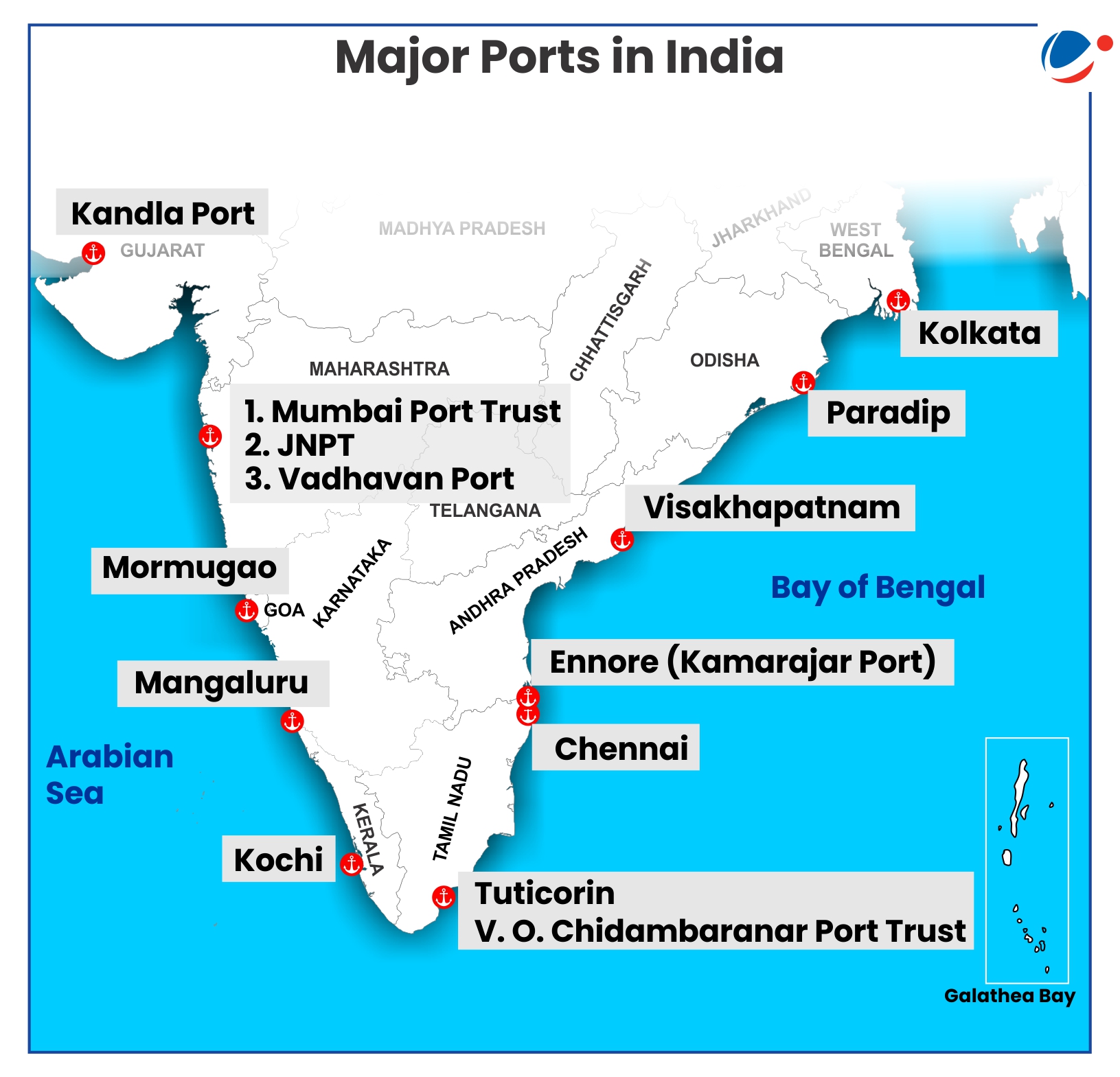Why in the news?
Prime Minister Narendra Modi laid the foundation stone for Vadhvan Port in Maharashtra's Palghar.
About Vadhvan Port
- Located near Dahanu town in Palghar district in Maharashtra.
- It will be established as the 13th Major port in the country.
- It will be the country's largest container port and one of India's largest deep-water ports.
- The Project will be constructed by Vadhavan Port Project Limited (VPPL), a Special Purpose Vehicle.
- VPPL is formed by Jawaharlal Nehru Port Authority (JNPA) and Maharashtra Maritime Board (MMB) with a shareholding of 74% and 26%, respectively.
- The initiative aims to establish a global maritime hub that will boost the country's trade and economic growth by accommodating large container vessels and ultra-large cargo ships.

Significance of Vadhvan Port
- Large Capacity: It is expected to handle 254 million tonnes of cargo annually, making it one of India's largest container port.
- Can accommodate very large container ships: The port, with a natural draft of approximately 20 meters, will accommodate large container ships that are currently unable to dock at most Indian ports.
- Modern port infrastructure: Equipped with state-of-the-art technology and infrastructure like deep berths and advanced cargo handling systems.
- Expected to generate employment opportunities and stimulate local businesses: Due to its proximity to the Western Freight Corridor and the Delhi-Mumbai Expressway it will create new business opportunities and warehousing opportunities.
- Aid trade flow and enhance India's maritime connectivity and global trade hub status: As it would act as a gateway for the IMEEC (India Middle East Europe Economic Corridor) and INSTC (International North South Transportation Corridor).
- Reducing transit times and costs: By providing direct connectivity to international shipping routes.
- Priority to sustainability: It incorporates sustainable development practices and stringent ecological standards, aiming to minimize environmental impact.
India's Port sector
- India is the 16th largest maritime country in the world.
- Indian Maritime Sector contributes to 95% of India's trade by volume and 70% by value.
- According to World Bank's Logistics Performance Index, India ranks 22nd in the International Shipment category, with a better "Turn Around Time" of 0.9 days compared to the USA, Australia, and Singapore.
- The Indian port sector is divided into two segments: major ports and non-major ports.
- India has 12 major ports (13th Vadhvan and 14th Galathea) and 200+ non-major ports.
- The Ministry of Ports, Shipping & Waterways controls major ports in India:
- Chennai, Cochin, Deendayal (Kandla), Jawaharlal Nehru (Nhava Sheva), Kolkata, Mormugao, Mumbai, New Mangalore, Paradip, Visakhapatnam, VO Chidambaranar (Tuticorin), and Kamarajar Port Ltd.
Major Ports | Minor Ports |
|
|
Persistent Issues in India's Port Sector
- Financial Challenges: Difficulty in accessing financing from banks and financial institutions, deterring private sector participation.
- Regulatory and Approval Issues: Delays in obtaining government approvals and environmental clearances
- Infrastructure and Connectivity Problems: Inadequate-road networks within port areas and poor hinterland connectivity and Lack of basic infrastructure in remote locations for greenfield projects
- Labor and Productivity Issues: Overstaffing with unskilled and untrained labor in major ports and Frequent labor strikes
- Operational Inefficiencies: Outdated port designs inadequate to meet needs for quick turnaround and increased cargo volumes
- Existing Port Upgradation: High costs associated with upgrading older, government-owned ports and there is resistance to change in government-controlled port operations.
- Dredging issues: The dredging sector in India faces operational challenges such as lack of standardization, outdated equipment, inefficient soil investigation, and a shortage of trained personnel.
- Dredging is a routine necessity in waterways around the world because sedimentation—the natural process of sand and silt washing downstream—gradually fills channels and harbors.
Way forward
- Port Modernisation: Increase cargo handling capacity by:
- Enhancing the minimum draft (minimum depth of water needed by a vessel for safe navigation) of Indian ports through dredging
- By implementing modern cargo handling techniques.
- Enhancing connectivity by:Conducting environmental impact assessment before releasing funds for connectivity projects to avoid project delays.
- Linking private ports with major and minor ports.
- Encouraging Public Private Partnership (PPP) Projects by:
- Rationalising taxes to attract foreign shipping companies
- Providing financing to private sector for modernisation of non-major ports
- Creating a specialised maritime fund for supporting inland waterway operations and vessel financing through PPP mode
- Clearances: Fixing timeframe for timely regulatory clearances and setting up a single window approval system for PPP projects.
- Rationalise documentation, process all documents through a common digital platform proposed as "National Portal for Cargo Facilitation".
Initiative taken for port sector in India
|
Related News: Galathea Port The Central Government notified the Galathea Port in exercise of the powers conferred by section 5 of the Indian Ports Act, 1908.
Significance of ICTP at Galathea Bay in Andaman & Nicobar
|






